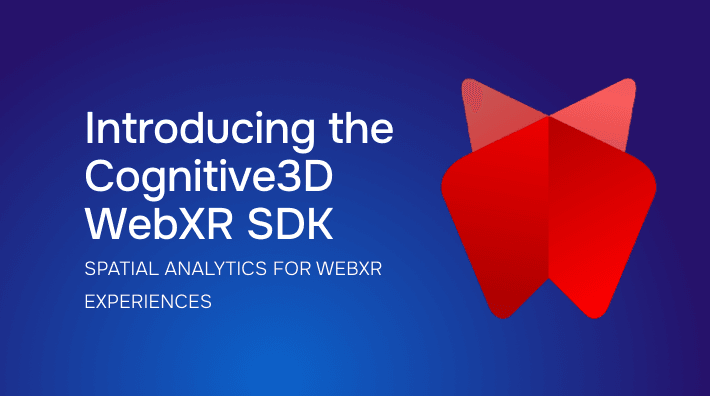Introducing the Cognitive3D WebXR SDK — Spatial Analytics for WebXR Experiences




Introducing the Cognitive3D WebXR SDK — Spatial Analytics for WebXR Experiences
The future of immersive experiences is no longer confined to native apps or closed ecosystems. With WebXR, virtual, augmented, and mixed reality are accessible via the web — across browsers, devices, and platforms. Today, we’re proud to bring Cognitive3D’s enterprise-grade spatial analytics to WebXR with our brand-new WebXR SDK.
Whether you're building a browser-based VR game, an AR visualization within the web, or a hybrid spatial experience — the WebXR SDK gives you the tools to capture, replay, and analyze user behavior in 3D space. Think of it as the analytics backbone for Web-based spatial content.
Why Spatial Analytics Matter — Even on the Web
In traditional web-based XR apps, analytics tell you which buttons got clicked, how long people lingered on a page, and which features converted. But immersive web experiences demand deeper insight:
- Where do users look — and when?
- How do they traverse your virtual scene?
- Which assets attract attention, and which fade into the background?
- Do users complete spatial tasks, or get lost in 3D space?
With spatial analytics embedded in WebXR, you can turn intuition into data-driven design. You can optimize usability, validate flow, debug performance, and prove ROI — all within the browser environment.
What the WebXR SDK Enables
Our WebXR SDK is built for flexibility and power. Key features include:
✅ Session & Scene Management Track user sessions, break them into named “scenes,” and gather structured session metadata — giving context to in-session behavior.
✅ Gaze / Fixation Tracking (when supported) Where available, capture gaze and fixation data automatically to generate visual replay, heatmaps, and aggregated insights.
✅ Performance Monitoring Record framerate, frame timing, memory usage, and other key performance metrics to help you diagnose bottlenecks across devices.
✅ Custom Events & Properties Log domain-specific actions (e.g. “buttonTapped”, “avatarPicked”) and attach context via custom user, device, or session properties.
✅ Dynamic Object Tracking & Scene Export Upload scene meshes, track moving or interactive objects, and tag them to align analytics with your spatial environment.
And whether you're using a full-fledged 3D engine or vanilla WebXR — the SDK adapts, offering seamless integration through adapters or a lightweight core.
Framework Support & Integration
We know developers use a variety of frameworks — so we’ve built adapters and integration paths to match. Supported options include:
- Three.js — A full-fledged adapter that hooks into rendering pipelines, spatial logic, and scene graphs for strong automation of gaze, scene export, and analytics.
- PlayCanvas — A drop-in integration for PlayCanvas WebXR projects, including built-in performance instrumentation.
- Wonderland Engine — Component-based integration, fitting into the architecture of Wonderland’s engine.
- Plain WebXR / Vanilla JavaScript — You still get session tracking, custom events, and user/property features; optional features like gaze or scene export work if you wire them manually.
By integrating at the right layer (render loop, XR session events, scene graph), each adapter lets the SDK capture rich metrics without bulky boilerplate.
Once a session ends, collected data is uploaded to your Cognitive3D dashboard, where you can replay spatial behavior, generate gaze heatmaps, analyze performance, and slice metrics by user, session, or variant.
WebXR Analytics in Action: Use Cases
Here are just a few ways teams can use the WebXR SDK:
- Immersive Training & Simulations Understand how learners navigate virtual environments in the browser, which areas they explore, and where they struggle.
- AR / Web-Based Product Showrooms Measure gaze on product models, interactions with annotations, and spatial navigation patterns.
- Educational & Scientific WebXR Apps Observe spatial exploration in VR for lab visualizations, anatomy models, or virtual field trips — all with web reach.
- Performance Diagnostics Across Devices Compare real-world browser performance across mobile VR, standalone headsets, and desktop WebXR to find optimization paths.
Enterprise-Grade & Built for Scale
Cognitive3D has already powered hundreds of millions of immersive minutes across XR devices. With the WebXR SDK, developers and organizations can:
- Centralize analytics across immersive platforms (native + web)
- Validate spatial UX across experiences
- Monitor performance and stability at scale
- Embed analytics as a foundational layer, not an afterthought
We deliver analytics that are platform-agnostic, secure, and enterprise-ready.
Looking Ahead
The WebXR space is evolving fast, and so is our SDK. Upcoming enhancements include:
- More automations for non-engine scenarios
- Advanced analytics features (fixation clustering, spatial funnels, heatmap comparisons)
- Offline-first support or local buffering
- Better onboarding templates, sample projects, and tooling
We’re excited to partner with the community to push spatial analytics forward on the web.
Ready to Dive In?
Check out our WebXR SDK documentation to explore integration guides, sample projects, and reference material. Or drop us a line to see how Cognitive3D’s analytics can power your immersive web experience.
The web is becoming spatial. With the Cognitive3D WebXR SDK, you don’t just build in 3D — you measure, understand, and optimize.